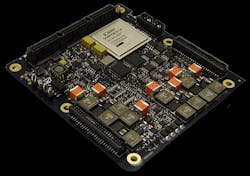NASA Marshall chooses PCI/104 rad-hard power card from Andrews Space for CubeSat design
Officials of the National Aeronautics and Space Administration (NASA) Marshall Space Flight Center in Huntsville, Ala., have issued a sole-source order from Andrews Space for the company's Cortex 130 CubeSat power system.
Only the Cortex 130 is rated for 15 kilorads of total ionizing dose (TID) radiation and has sufficient power outputs for a CubeSat under development at NASA Marshall, NASA officials say, and no other power system card has been found that is compatible with NASA requirements.
A CubeSat is a type of miniaturized satellite for space research that usually has a volume of exactly one liter, has a mass of no more than 1.33 kilograms, and typically uses commercial off-the-shelf (COTS) components for its electronics. Typically this mini spacecraft is about the size of a large softball.
The Andrews Space Cortex 130 power system provides power conditioning, lithium ion battery charging, and supports external solar arrays. The card is a CubeSat form factor, and offers dual power conditioning circuits and independently programmable bus voltage from 3.7 to 28 volts DC.
The system has a 28-volt DC output connector, lithium-ion battery charger controllers, three solar array string inputs with a peak power tracker rated from 3.5 to 35 volts DC. The system also has four programmable power supplies, each able to provide 3 amps at 35 Watts, six 0-to-5-volt configurable analog inputs, three 0-to-3.3-volt configurable analog inputs, and six sun sensor analog inputs.
The power system card provides power conditioning and battery charging for high-power payloads and buses, and provides bus power management through a PCI/104 backplane with the other cards in the avionics stack.
It can be used as standalone avionics element or installed in a Cortex frame for use in a Cortex avionics suite. The card has a Xilinx Virtex 4LX field-programmable gate array (FPGA), and is tested for random vibration, thermal cycling, and burn-in.
Related: IR introduces LSO Series rad-hard DC-DC converters for satellite power systems
Companies whose officials believe they can offer competitive CubeSat power systems may email NASA Marshall's Sonja White no later than 12 June 2015 at [email protected].
Additional information about this CubeSat power system order is online at https://www.fbo.gov/spg/NASA/GMSFC/POVA/NNM15549852Q/listing.html.
For more information contact Andrews Space online at http://andrews-space.com, or NASA Marshall Space Flight Center at www.nasa.gov/centers/marshall/home.
